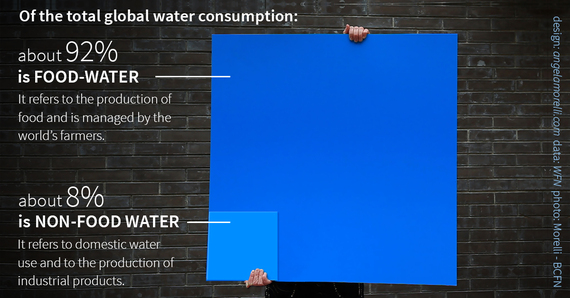If you have wondered if there is enough water to support a future global population of 9 billion people, the good news is that the answer is yes. But only if we eat sensibly, we don't waste food and, most of all, we support our farmers.
When I started my fascinating journey through the world of communicating water science, I never imagined what I was about to discover.
Discovery n° 1:
blue versus green
I thought there was one color for water: blue. But water scientists tell you that there are two: blue and green.
Blue water is the water in rivers, streams, lakes, underground reservoirs. It can be diverted from rivers or pumped from groundwater. We can see it, feel it, drink it.
Green water is the water hidden inside trees, soil, plants. Anywhere you see a flash of green, that means there is water. It is invisible but really important, because green water raises most of our food.
Discovery n° 2:
food-water versus non-food water
For years I had been bombarded with powerful advertising campaigns that urged me to save water while brushing my teeth or while flushing the toilet. That is extremely important, but water scientists tell us that a big problem lies in what we eat, in how we produce what we eat, in how we trade what we eat, and in how much food we waste.
How is this so? you might ask.
Well, a startling statistic is that about 8 percent of the total global water consumption refers to domestic services such as drinking, cleaning, washing, and to the production of industrial products such as steel, paper, clothes. This 8 percent can be called non-food water. All of it is blue water, it can be treated after first use (at a cost) and can be recycled.
A colossal 92 percent of the total global water consumption is nearly all used in food production (a remaining bit is for cotton, other fibers and bioenergy). This 92 percent can be called food-water and is managed by the world's farmers. Most of it is green water, it is in the soil and is lost to local users. It is recycled to the atmosphere in the natural global water cycle, but it cannot be recycled locally. The rest is blue water, it is pumped from rivers or underground reservoirs and is used for irrigation. Very little of the water used for irrigation is re-cycled.
Discovery n° 3:
drinking water versus eating water
I discovered I eat a lot more water than I drink!
How? If we see a packet of pasta we see just that. We forget about all the water used in growing the wheat, producing the packaging or transporting the product. All products have a water cost and some are more water friendly than others. Where food is concerned, fruit and vegetables are more water friendly. Meat raised on irrigated feed much less so.
The amount of meat in our diet is crucial. The average daily water consumption of a meat-eating person is 5000 litres of water per day (1300 gallons). The average for a vegetarian is 2500 litres (660 gallons). In countries where there is a culture of heavy meat consumption, the advice is: one meat-free day a week.
Discovery n° 4:
farmers versus food supply chains
I discovered that, if we want to secure our planet's water future, we need to secure the future of farmers.
Around 90 percent of the water we use is for food production. Every last drop is managed by the world's farmers. With the help of science and technology, they have performed greater and greater miracles in improving water productivity -- in getting more crops per drop.
We depend on farmers to produce food and steward water ecosystems, but we are not helping them fulfill the task. The prices farmers receive for the food they produce are too low to cover production and stewardship costs and they are vulnerable to volatile weather and volatile markets. We need to protect farmers if we want to guarantee a future for humanity.
Food supply chains are a key factor. It is via the food supply chains that the food the farmers produce reaches us. Yet food supply chains deliver food at prices that do not reflect the value of the water used to produce it. Food supply chains are blind to water. They ignore it, with the result that we nurture the unethical habit of wanting cheap food to be able to trash 40 percent of it.
Society and politicians must wake up and recognize that we need to change the way food markets and food supply chains value water and account for it. The powerful players in food supply chains -- the corporate brands, the global traders and especially the supermarkets -- must be made to feel that their reputations depend on leading us into ways that secure our water futures. They can only do this with appropriate regulation agreed by consumers. Each of us is a voter and a consumer. We are key.
If we really want to have enough water to support a future global population of 9 billion people we should protect the world's farmers, because they play such a crucial role in managing 92 percent of the water we use, by producing the world's food.
If someone tells you that it would be wise to have a shorter shower to save humanity, answer that a quicker shower is important, but that to really save humanity, we need to protect our farmers.
Credits
I thank Professor Tony Allan, David Stonestreet, Professor Arjen Hoekstra, Martin Keulertz and Tom Gabriel Johansen for their input.
References
Info-graphic stories: The Water We Eat, Food is for Eating, TEDx Oslo
Hoekstra, A. Y., Mekonnen M. M., 2011, The water footprint of humanity, The Netherlands: University of Twente
Allan, J. A., 2011, Virtual Water: tackling the threat to our planet's most precious resource, London: I B Tauris
